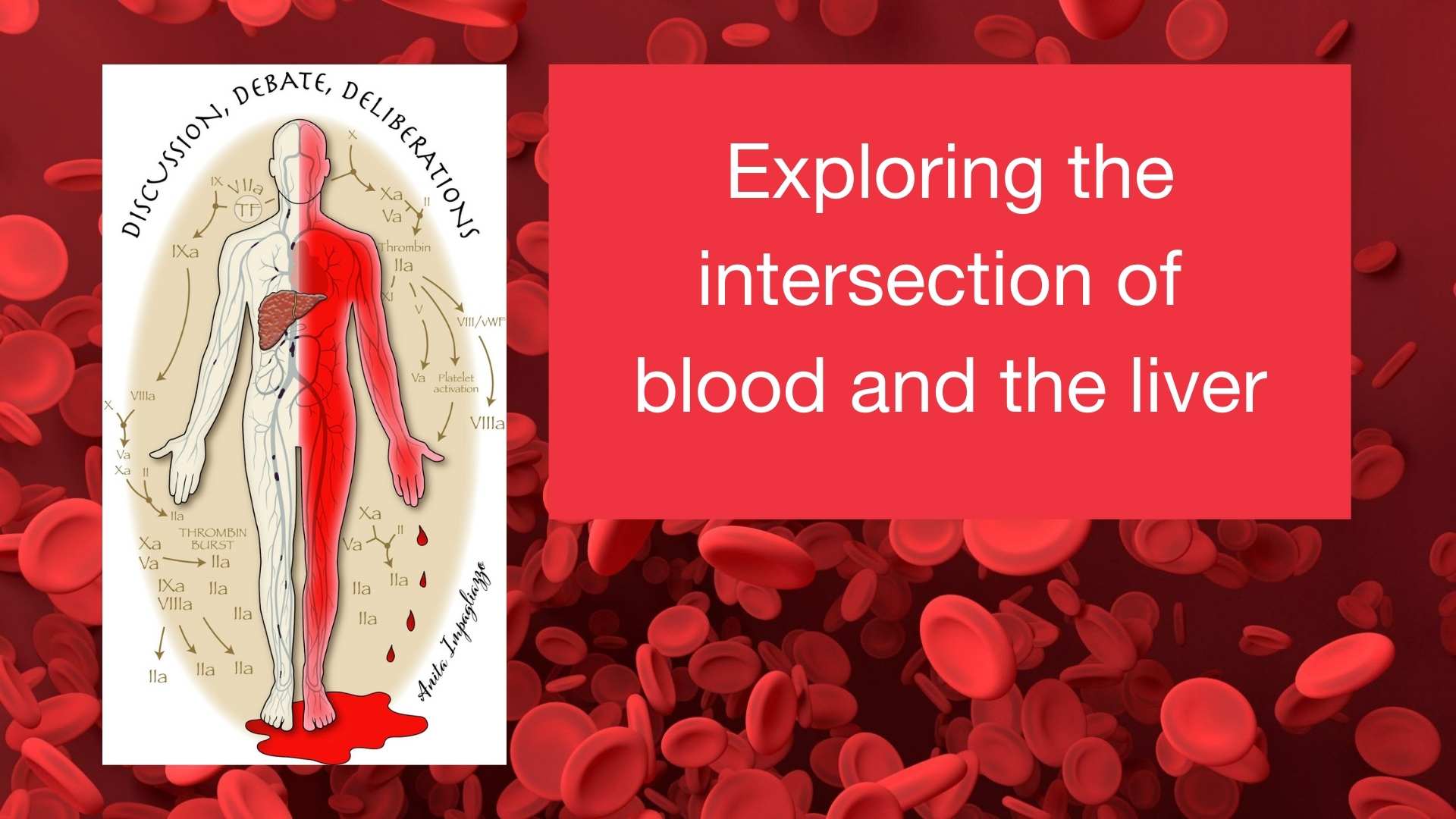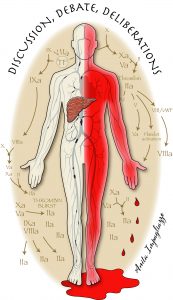Exploring the intersection of blood and the liver

9 August 2021
From grassroots to an EASL event
EASL’s monothematic event, Bleeding, Thrombosis, and Vascular Liver Diseases, is coming up soon, 7–9 October 2021. This meeting of blood-meets-liver enthusiasts has a fascinating grassroots history, which EASL member, Dr Stephen Caldwell, has been part of from the start. He told us how this niche area of hepatology was developed and led to a series of meetings, of which 2021 is being hosted by EASL. This event is also officially endorsed by the International Society on Thrombosis and Haemostasis (ISTH).
About twenty years ago, a small and driven grassroots group of about 100 clinicians and researchers from diverse fields, all particularly interested in how the clotting cascade acts in patients with liver diseases, joined forces. Their purpose was to create a forum to explore in depth the particular and vexing blood-related difficulties that they and their liver patients faced: not only bleeding, but also thrombosis, coagulation pathways disorders, and other vascular challenges in liver disease.
The 2021 EASL monothematic conference, Bleeding, Thrombosis, and Vascular Liver Diseases is endorsed by the International Society on Thrombosis and Haemostasis.
From 2005 to 2019: fostering discussion, debate, and deliberations on how blood behaves
The founders, later termed the Coagulation in Liver Disease (CILD) group, held their first event in 2005 in Charlottesville, Virginia, USA. The initial meeting, supported by the kind work of Margaret Fisher of Novo Nordisk, included individuals from remarkably diverse fields, such as: hepatology, critical care medicine, anaesthesiology, transplant surgery, haematology, basic science investigators, pathology, laboratory medicine, paediatric gastroenterology, veterinary medicine, and even the field of medical-legal medicine (to address the practice of defensive medicine, which sustained many of the conventional approaches to these problems).
Read more
The meeting has always been run on an essentially volunteer basis, without any speaker stipends. The support of Mr Jack Chambers served as the lifeblood of this recurring event, enabling renting of venues and providing modest travel support and accommodation for the volunteer . The motto of the biennial meeting eventually became: “Discussion, Debate, Deliberations” and each meeting was given a thematic title, as the field evolved.
Over the years, the meeting provided the seedbed for many fruitful collaborations between very diverse groups and the development of ongoing research efforts. These were highlighted at the 2013 meeting in Padua, Italy, themed “Shifting the Paradigm”.
A logo capturing the complexity of the topic
A logo was created and donated for the first meeting in 2005 by Charlottesville-based medical illustrator, Anita Impagliazzo, to capture the complexity of this field – a human figure showing clotting on one side of the body, but bleeding on the other side. Surrounding the figure lies a sketch of key reactions in the coagulation cascade. (This image captures the paradoxical and often conflicting forces causing disequilibrium in cirrhosis-related haemostasis, driven mostly by portal hypertension, but complicated by an acquired protein C-deficient hypercoagulable state and sometimes by bleeding related to dysfunction of the thrombolytic system.)
Gaining a wider global reach and broadening topics
This human figure, referred to fondly as “Bloody Guy”, became the key visual for the six subsequent two-day events that were organised by the CILD group, with evolving connections to related and interested organisations worldwide, especially in Europe and the USA.
The meetings were held in different cities across the globe from the initial event in Charlottesville, Virginia, USA, to Groningen, The Netherlands; London, UK; Padua, Italy; and Rome, Italy. The attendance, consistently ranging from about 80 to 120 professionals from diverse specialities, catalysed the interest and endorsement of EASL.
Core themes, evolving year by year
Read more
Year by year, certain concepts took centre-stage at each meeting and the meeting was named according to its aim:
- 2005: Navigating the Cascade: defining basic haemostatic pathways in normal and liver disease patients ([in] Charlottesville, [organised by] Caldwell)
- 2007: Currents and Counter Currents: refining the definitions and controversies from 2005 (Charlottesville, Caldwell)
- 2009: Back from the Bench, Now to the Bedside: translating issues from prior meetings to clinical testing (Groningen, Lisman/Porte)
- 2011: Bleeding and Thrombosis: capturing the paradoxical issues of simultaneous bleeding and thrombotic risks in these patients (London, Burroughs)
- 2013: Shifting the Paradigm: highlighting changing perceptions of haemostasis and laboratory assessment in cirrhosis (Padua, Senzolo/Simioni)
- 2015: Discussion, Debate, and Deliberations: refining new clinical/translational research goals based on past milestones (Charlottesville, Intagliata/Caldwell)
- 2017: Refining New Concepts: Bridges and Gaps: refining clinical/translational research aims based on past tenets and emerging concepts in cirrhotic haemostasis (Violi, Rome)
- 2019: Coagulation and Liver Disease: critiquing prior studies and establishing future collaborations from clinical and basic science perspectives (Groningen, Lisman/Porte)
Through the years, each meeting had a unique twist, especially with the development and growth of unexpected collaborations, as a result of people from diverse backgrounds coming together. The early meetings generally focussed on challenging old dogma. The 2013 meeting (Padua, Senzolo/Simioni) was a turning point, as new and better-founded paradigms started to be noticed and carefully investigated further. The 2015 meeting was special for us, as it came back around to Charlottesville. Most memorable to me from that meeting was the Pathologists’ perspective on thrombotic mechanisms in parenchymal extinction or liver atrophy[1] – when things really start to fall apart for the patient
said Dr Stephen H. Caldwell, Professor of Hepatology at University of Virginia, USA, who has been been involved in this event since the very start.
Much in the field remains unsettled and is yet to be learned, even today. I can give a key example: one of the most enduring debates in this field is the clinical diagnosis of hyperfibrinolysis responsive to anti-fibrinolytic agents and the inability of even advanced laboratory testing to provide a simple measure of this. Is the diagnosis off or is the lab missing the mark? Another really key area is whether or not prophylactic anti-coagulation can stave off organ atrophy. This is of the utmost importance to investigate, regarding especially the establishment of risk versus benefit. Future meetings will help us unravel the answers.
[1] With credit to the pathologists involved: Y Ikura, C Lackner, D Kleiner and I Wanless
Moving forward in 2021 together with EASL
The COVID-19 pandemic has created setbacks for the world, but vital questions remain for us in the treatment of liver patients: the role of the haemostatic cascade in liver disease progression and safe haemostasis or anti-coagulation. And yet further questions remain. So this year, EASL is hosting the next iteration, as an EASL monothematic conference, Bleeding, Thrombosis, and Vascular Liver Diseases, 7–9 October 2021, face to face in Geneva, Switzerland.
We welcome everyone involved in the management of liver disease patients: including hepatologists, gastroenterologists, radiologists, interventional radiologists, haematologists, transplant and general surgeons, anaesthesiologists, intensive care doctors and nurses, hospitalists (often providing frontline care for these patients), anatomical and clinical pathologists, and basic scientists interested in the underlying mechanisms of haemostasis and the haemostatic cascade, and/or liver disease. We look forward to forging further progress in this challenging intersection between hepatology and haematology, and to catering to the interests, needs, and passions of those interested in this topic.
We remember the unique circumstances that allowed this unique meeting to come about. We strive to serve the patient community better, as we learn more. Let the discussion, debate, and deliberations continue!



